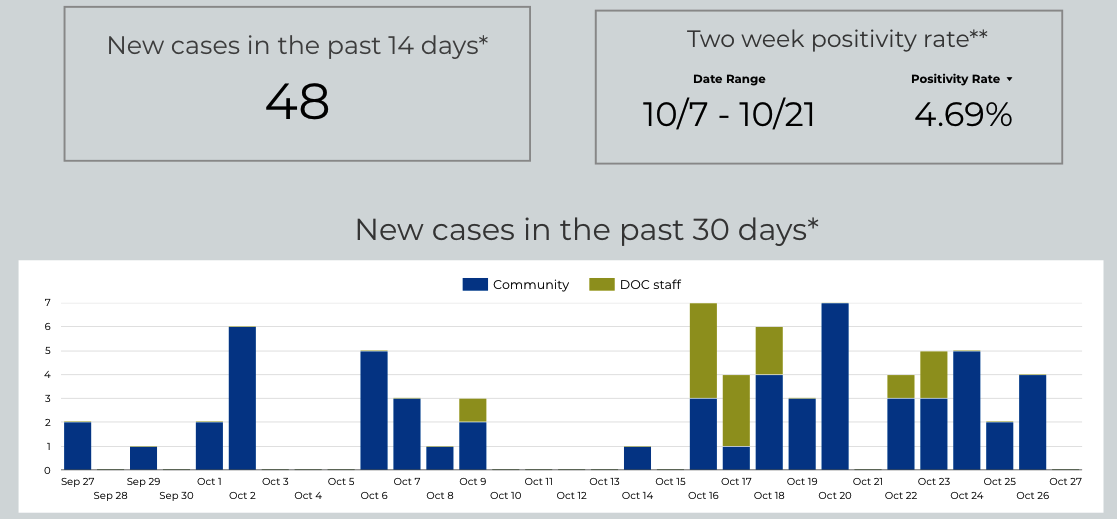Like the state of Colorado, Chaffee County is still seeing increasing cases of COVID-19, with 48 cases in the past two weeks, and 27 in the past week alone. Since Oct. 1, there have been 68 new cases reported in the county, including staff and inmates at the Buena Vista Correctional Complex (BVCC).
BVCC is currently operating on Phase III operations, Department of Corrections Public Information Officer Annie Skinner told Ark Valley Voice.
“There have been a total of 23 positive staff members, and staff testing will occur again tomorrow, Skinner said.
In the first inmate testing cycle there were 23 positives. In the second inmate testing cycle there were two positives, bringing the total to 25 inmates. Inmate and staff testing will be ongoing, and is currently being conducted weekly, Skinner added.
The county infection positivity rate based on recent testing, was listed at 4.69 percent, but that was based on data from Oct. 7 to Oct. 21. Since then, 20 more cases have been confirmed and about 30 test results were still awaited on Oct. 27.
The latest local infections range widely, from 22 year-old women to an 85-year-old woman and an 84-year-old man. All were reported resting at home. Just one prior COVID-19 patient was listed at the Heart of the Rockies Regional Medical Center.
The state overall has seen an alarming increase in the number of reported cases and hospitalizations, something health officials are wary of, especially with the holiday ahead. The latest positivity rate for the state was above seven percent, with new cases reported at 1,211 on Oct. 27 as well as 49 new hospital admissions.
Denver Mayor Michael Hancock today announced a return to the second-highest level of restrictions. The Denver Post reported it will mean that restaurants, churches and most businesses will have to cut back to operate at one-quarter of their capacity.
In order to return to looser restrictions, Denver must cut its rate of new cases by more than half, and keep them down for at least two weeks.
The Post said 375 cases were reported Sunday, the most since the pandemic began. Worse, the death rate nationally has also gone back up, which health officials expected to occur with the surge in cases across so many states recently.
Chaffee County Public Health Director Andrea Carlstrom told a COVID-19 town hall session last week that the rising numbers locally are a concern and that residents have to take the virus seriously and adhere to the rules to prevent further spread as we enter the flu season.
She also said healthcare workers are as fatigued as many citizens after eight months of dealing with the deadly disease.
“However, we have some tough days ahead of us,” stressed Carlstrom and everyone needs to protect the health of the community. “There will be an end to this, she added, “but that time is not now, and it will happen sooner if we all work together.”
Linda Smith, San Luis Valley (SLV) Public Health Partnership Coordinator said the San Luis Valley’s cumulative total of COVID-19 cases as of Oct. 26, stood at 679. There were 84 total new cases in the past two weeks, and currently there are 75 known active cases.
The latest SLV totals:
Alamosa County- 44
Conejos County – 14
Costilla County – 1
Mineral County – 0
Rio Grande County – 9
Saguache County – 7
Smith also cautioned about the upcoming holiday season. “… we recognize the importance of family and friends. We need one another. Our recent concerning influx of new COVID-19 cases has brought home the importance of our social connections. A typical scenario involves one family member coming down with the virus, and passing it along to one or more family members before they know they have the illness,” Smith said. “Those of us who are at lower risk for severe outcomes from COVID-19 are the most likely to be exposed to it and bring it home to loved ones,” Smith added.
In the San Luis Valley, young adults ages 20-29 have had more cases than any other age group, closely followed by those in their 30s and 40s. However, all of the deaths in the region have been in people age 50 and older. “It is not enough to just be careful when you visit your grandparents,” Smith cautioned. “Your actions the rest of the time also play into how likely you are to unintentionally carry a virus to someone you love,” Smith added.








Recent Comments